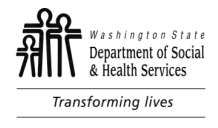 The WSU Social and Economic Sciences Research Center (SESRC) worked collaboratively with the the former Division of Behavioral Health and Recovery, now part of the Health Care Authority to conduct the 2017 Behavioral Health Provider Survey.
The WSU Social and Economic Sciences Research Center (SESRC) worked collaboratively with the the former Division of Behavioral Health and Recovery, now part of the Health Care Authority to conduct the 2017 Behavioral Health Provider Survey.
The was open to behavioral health treatment agencies who provide DBHR-certified, publicly-funded mental health and substance use disorder treatment services. The aim was to collect current information regarding services and clinical staff to help identify opportunities for improve the quality of behavioral health treatment services in Washington State.
in Washington State completed the survey online, giving a response rate of 65%.

- 42% offer both mental health and substance use disorder (SUD) treatment
- 40% offer mental health services only
- 18% offer SUD treatment only
- 37% have at least 1 staff person who is dually credentialed to provide both mental health and SUD treatment

- 63% referral to appropriate community programs
- 33% peer-to-peer counseling
- 32% housing assistance and services
- 23% educational counseling
- 21% family and marriage education
- 20% skills development and job training
- 18% employment services support

- 79% of organizations have a process in place to assess staff cultural competency
- 90% have a policy that requires staff to complete a cultural competency training
- 90% offer interpreter services to individuals whose primary language is not English
- 83% offer interpreter services to individuals who are deaf or hard or hearing
- 93% integrate clients' cultural beliefs, practices, and traditions in treatment planning

- 35% of organizations offer services specifically designed for youth
- 34% for women
- 29% for men
- 20% for Hispanics
- 20% for LGBTQ
- 20% for people experiencing homelessness
- 17% for people with development disabilities
- 16% for Native Americans
- 12% for African Americans
- 11% for Asian/Pacific Islanders
- 9% for individuals who are deaf or hard of hearing
- 8% for individuals who are blind or visually impaired

- 75% Engage clinicians in trainings
- 64% Follow up with clients
- 62% Have meetings or other contact with family members
- 56% Offer flexible scheduling
- 53% Provide transportation or transportation vouchers
- 48% Monitor client outcomes (e.g., homelessness, unemployment, incarceration, hospitalization)
- 41% Provide peer support
- 29% Offer recognition or incentives for staff when high levels of retention and outcomes are achieved
- 27% Co-location of other services
- 22% Offer clients participation incentives/contingency management
- 20% Use child and/or family teams
- 12% Link clients with sponsors
- 6% Offer on-site child care

- 87% Obtain client signature on consent forms so clinicians can exchange information
- 77% Establish phone/fax contact with the other level of care setting regarding the client
- 74% Talk with case managers
- 66% Call the other level of care location to alert them that the client is coming
- 48% Send the client file

- 87% Formal grievance procedures
- 79% In-house satisfaction surveys
- 38% Suggestion box
- 32% Community meetings
- 27% Client or consumer representation in an agency board of directors or advisory board
- 23% Post-treatment contact with clients

- Nearly 50% include education goals in the treatment or post-discharge plan to help youth clients achieve their educational goals
- 39% Talk to youth about vocational training, apprenticeships, and other on-the-job learning opportunities
- 38% Refer clients to GED programs in the community
- 73% Refer patients to employment programs in the community to help unemployed clients find job opportunities
- 68% Include employment goals in the treatment or post-discharge plan
- 64% Talk to clients about vocational training, apprenticeships, and other on-the-job training opportunities

- 80% Refer clients to housing programs in the community to help individuals experiencing homelessness find housing opportunities
- 69% Include housing goals in their treatment or post-discharge plan
- 62% Have staff who are knowledgeable about housing locator services
- 47% Have relationships with affordable housing providers
- 24% Participate in the Homeless Continuum of Care
- 12% Manage housing subsidies
- 11% Own housing stock




 The WSU Social and Economic Sciences Research Center (SESRC) worked collaboratively with the the former Division of Behavioral Health and Recovery, now part of the Health Care Authority to conduct the 2017 Behavioral Health Provider Survey.
The WSU Social and Economic Sciences Research Center (SESRC) worked collaboratively with the the former Division of Behavioral Health and Recovery, now part of the Health Care Authority to conduct the 2017 Behavioral Health Provider Survey.









